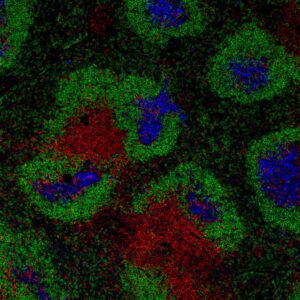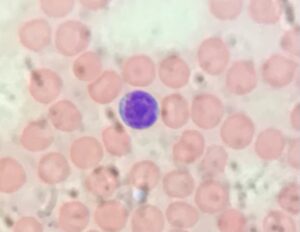It is the start of a new year. New goals, new planner, new routines. We know exactly what we have to do, when we have to do it, and we are ready to start strong! It is like a new cycle. Although nothing has truly changed from December 31st at 11:59 pm to January 1st at midnight, most of us get a new spark. Like a new beginning. But do you know who is not really caring about whether we have just finished a trip around the sun one more time? Our cells.
Our cells don’t really care, because they are always “organized” and “regulated”. In the ideal scenario, our cells are ready to perform their job at any point in time, with consistency and without failing… well, until they do fail.
Although we have spent a lot of time in the blog talking about the beauty of our internal mechanism of defence, sometimes it can actually fail, and when it does, we can develop different diseases such as cancer. Today, I’m extremely pleased to share with you the first ImmunoThoughts post to a new series. In this series, I will feature the work of graduate students around the world, trying my best to bring it as close to our daily lives as possible. (Reach out, if you would like to be featured in the blog!)
This series will start with an amazing immunology Ph.D. student (and dear friend) Miranda Yu. Miranda is a Ph.D. student at McGill University (Montreal, Canada) in the laboratory of Dr. Daniela Quail. She is devoting her time to better understand an aggressive type of brain cancer called glioblastoma. Thank you so much Miranda for taking the time to talk to me and to share your fantastic insights with our readers.
When will scientists find a cure for cancer?
It is sad to say, but most of us probably know someone that has had or has cancer. This illness arises when cells “decide” to divide uncontrollably. Although the word cancer is used to indicate a disease characterized by abnormal cell proliferation, there are actually many different kinds of cancer. Each with distinct causes and consequences.
Therefore, the question “when will scientists find a cure for cancer?” is very hard to answer. Instead of going broad, scientists spend their time studying a specific type of cancer. Drilling down to comprehend the precise mechanism of why cells are malfunctioning in each scenario. This allows us to get closer to find treatments for each specific cancer.
And this is when Miranda Yu comes in. She is dedicating her time to study glioblastoma, and in our virtual interview, she was very excited to tell us all about her project!
The game of Hide and Seek we don’t want to play
Glioblastoma is a type of brain cancer that arises when cells inside our brain, called astrocytes, proliferate uncontrollably and form tumors. Unfortunately, this type of cancer is extremely aggressive and there is currently no cure available. Moreover, current treatments (such as chemotherapy, radiotherapy and surgery) can only prolong life by a median of around 15 months. And this is why Miranda decided to use all her forces to better understand the mechanisms governing the establishment and persistence of glioblastoma.
Miranda explained to me that one of the reasons why glioblastoma is so deadly is because it is very good at creating an environment that helps it grow while escaping the immune system. Escape? Like, hide and seek? Yes, exactly!
Our immune system is usually great at discriminating healthy from unhealthy cells. In the ideal scenario, those “bad” cells are found and are removed. Easy, right? But here is the catch. Miranda told me that cancer cells modify themselves to actually prevent the killer cells from killing them.
Imagine you are playing hide and seek, and you know exactly which person you are supposed to find. However, as soon as you find that person, he/she turns to you and says: “Don’t worry, I’m not actually your target, just leave me here”. In the case of cancer, however, the “leave me here” is very dangerous, because these cells will keep proliferating, causing us harm.
Miranda explained that apart from “hiding” from the immune system, such malfunctioning cells can also recruit other specific cells that will help them grow, exacerbating the issue.
Her goal is therefore to understand the exact relationship between these glioblastoma cells and our immune cells. How do they hide? How do they persist? Once she (and other scientists) unravels the precise components leading to this issue, we can design a way to prevent this situation from happening.
Let’s say for example that the reason why glioblastoma cells are able to hide from the immune system is because they produce and express a specific “red flag” (for example, a protein). We can then design a treatment that would prevent the production of such “red flag”. Or we can make a treatment that would somehow “camouflage” this “red flag”, allowing our immune cells to find and kill glioblastoma cells.
Of course, we have to keep in mind that the scenario I presented above is very simplistic, in real life everything is much more complex. And this why we need amazing scientists like Miranda studying this process.
One size does NOT fit all
But it gets even more complex than that. Miranda explained that glioblastoma is actually very diverse, meaning that a treatment that would work for one patient, might not work for another. Even more impressive, a single patient can have different types of glioblastoma. Meaning that a treatment might cure one type of glioblastoma, but not another. Sadly, the type that is resistant to the treatment can take over (by proliferating) preventing the patients from being cured.
Miranda is very interested in understanding what makes one type of glioblastoma more resistant than another, with the hope of designing new treatments that would be specific to each type. This way we could give a combination of treatments for each patient, which would be particular to each type of glioblastoma the patient possesses.
Miranda has just started her journey on this topic, and don’t worry, I will definitely bother her in the near future with more questions on the subject. But if you are as excited as me and you can’t wait to hear more about her project, you can reach out to her on Twitter (@Miranda_WYu). Thank you so much Miranda, for taking the time to explain to us about your project using accessible language, I can’t wait to see what amazing science you will discover soon.
As always, thank you for stopping by for one more ImmunoThoughts.
Keep asking questions and seeking answers.
From your immunologist – in training,
Stefanie Valbon



